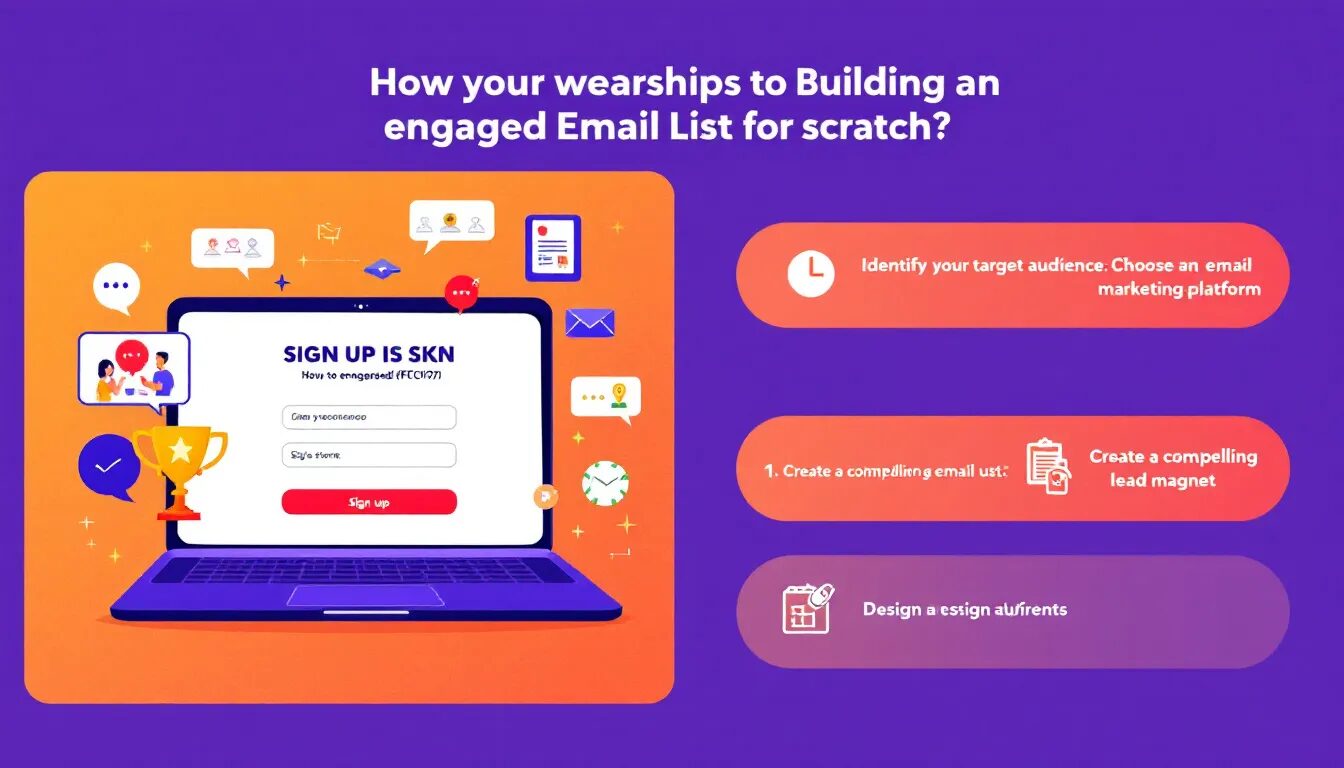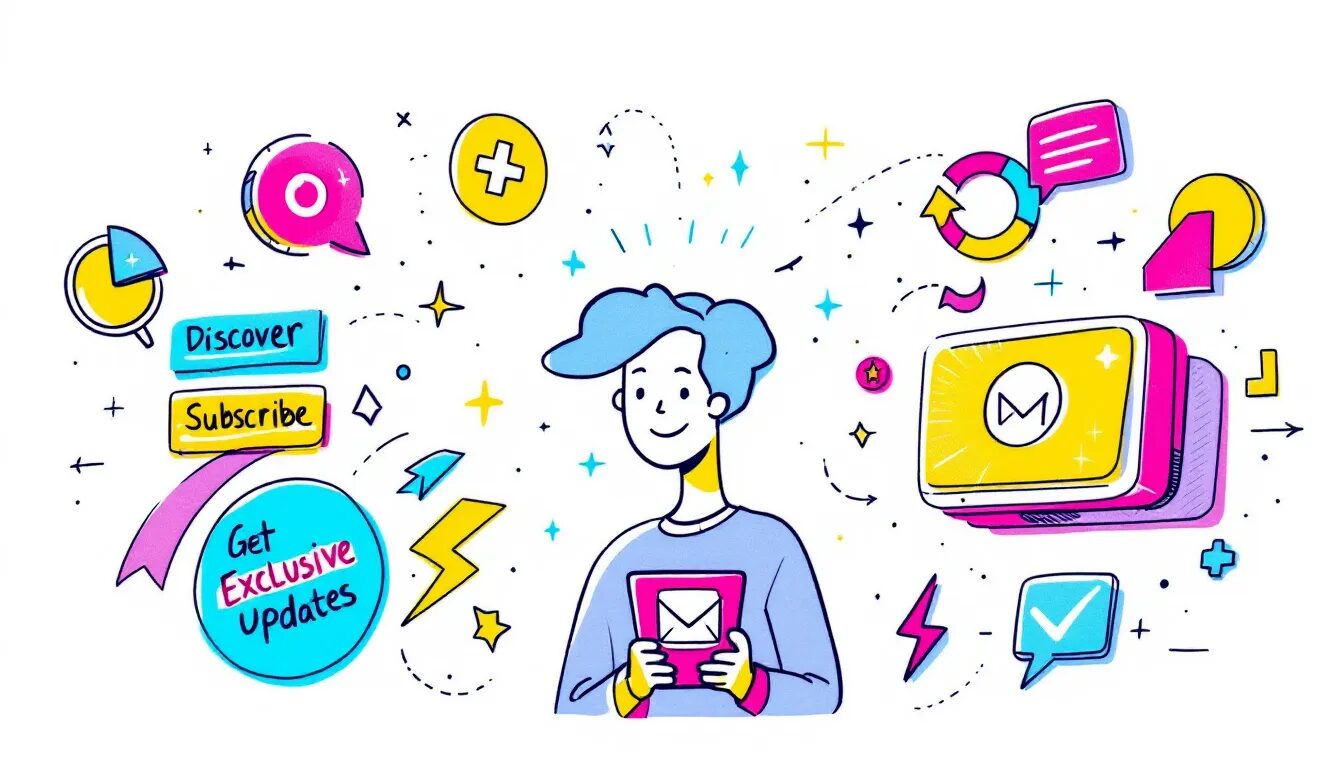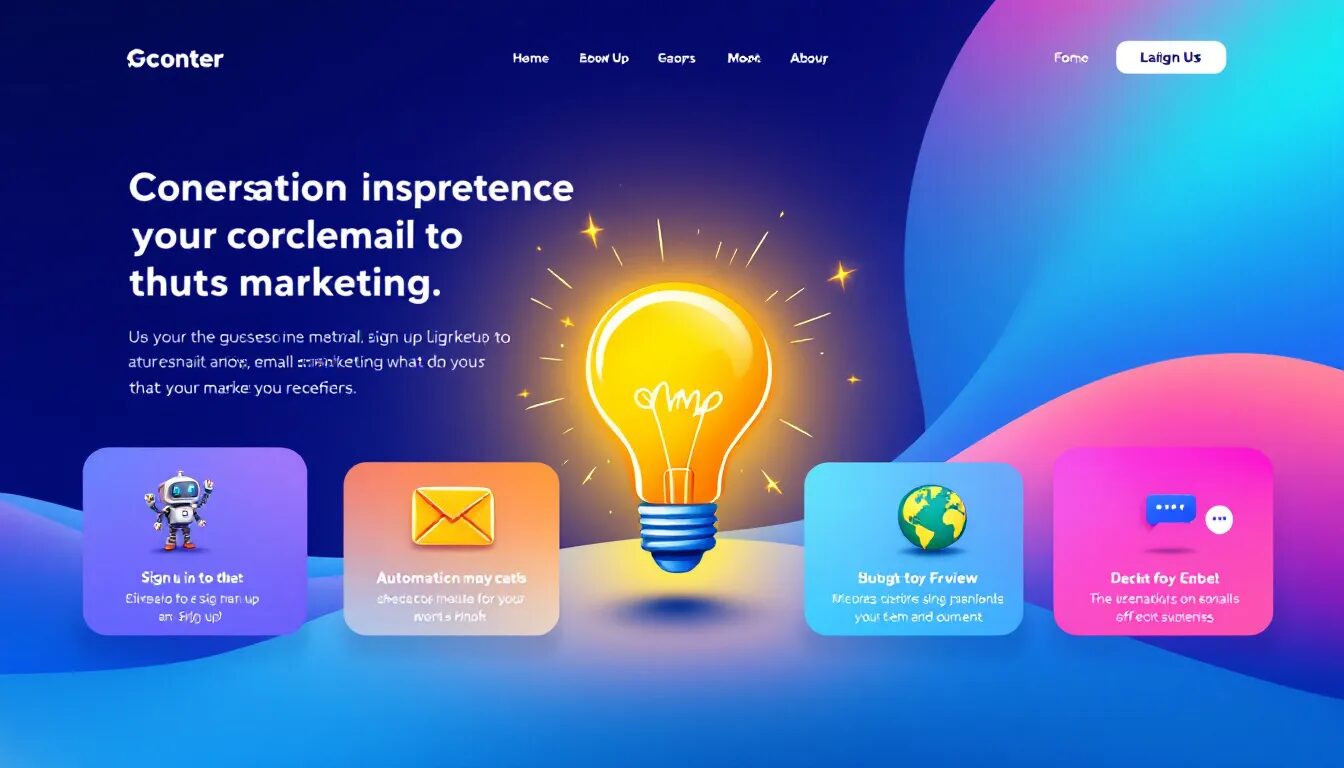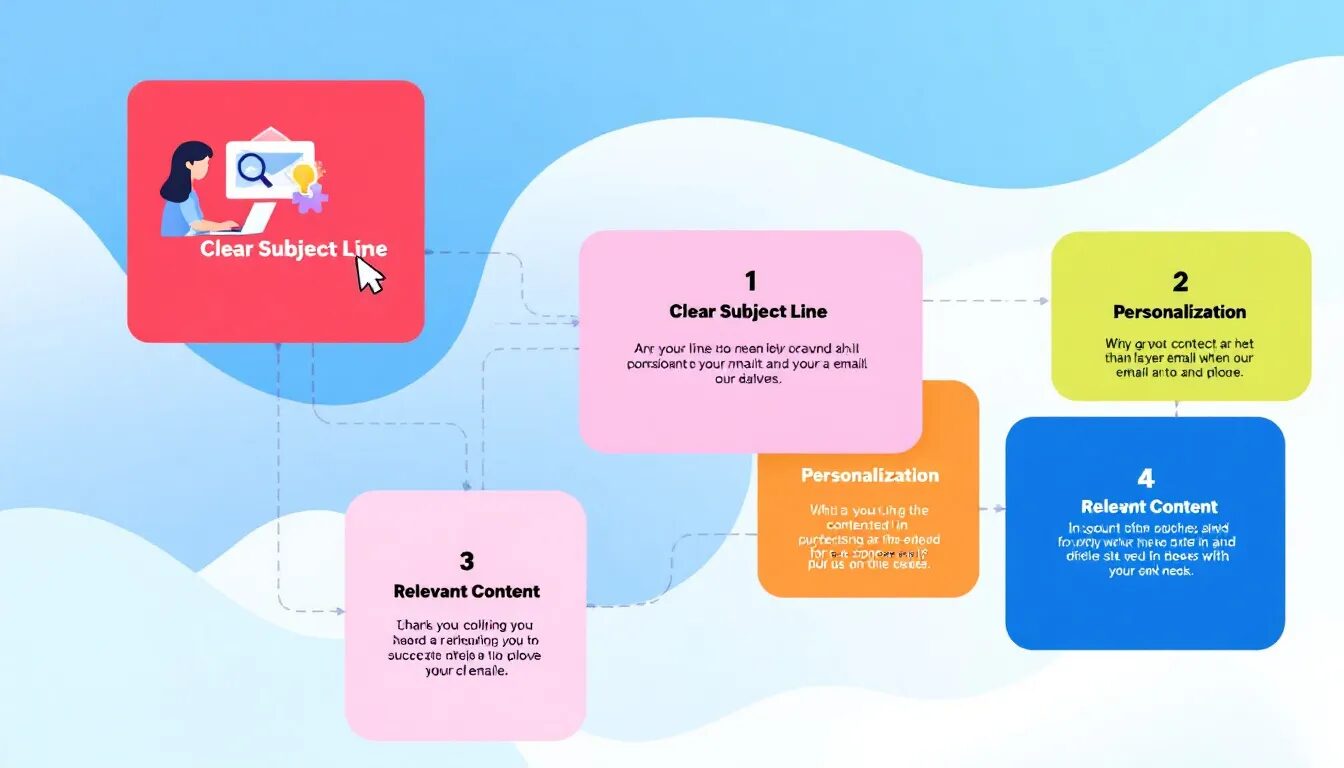Create your very own Auto Publish News/Blog Site and Earn Passive Income in Just 4 Easy Steps
Looking to learn how to build an engaged email list from scratch? Follow these steps to create a quality email list that actively engages with your content. This guide covers everything from creating effective signup forms to offering incentives and using social media.
Key Takeaways
- Start with a clear and optimized signup form to boost email subscriptions by enhancing user experience.
- Offer compelling incentives like discounts, exclusive content, and contests to attract and retain subscribers.
- Utilize social media and landing pages strategically to promote signups and engage a wider audience.
Create a Clear Signup Form

The foundation of any successful email list is a clear and user-friendly signup form. These forms are your primary tool to collect contact information from potential customers, and their design can significantly impact your conversion rates. The key is to keep your signup forms simple and straightforward, avoiding unnecessary elements that might create friction and deter sign-ups. Pop-up forms and landing pages can be strategically added to your website to capture email addresses more effectively.
There are several ways to optimize your signup forms, including their placement, design, and the information you request. Optimizing these aspects helps create an inviting and efficient signup experience, encouraging more visitors to opt in forms and subscribe.
Optimize Placement
Where you place your email signup form on your website can make a huge difference in your conversion rates. Forms placed above the fold, meaning they are visible without scrolling, generally perform better. Using a sticky signup form that remains visible as users scroll can also boost engagement by keeping the form always accessible. High-traffic pages, such as your homepage or popular blog posts, are prime real estate for your signup forms, ensuring they get maximum visibility.
Another effective strategy is utilizing exit-intent technology, which triggers a signup form when a user is about to leave your site. This last-chance effort can capture potential subscribers who might otherwise slip away. Strategic placement of signup forms can significantly increase the number of visitors who choose to subscribe.
Use Eye-Catching Design
An eye-catching design is crucial for grabbing visitors’ attention and encouraging them to engage with your content. A clean and minimal design approach, using a single-column layout, enhances user experience by reducing cognitive load and making the form easier to complete. This simplicity ensures that your signup form is visually appealing without being intrusive, which can significantly boost engagement and conversion rates.
Incorporate a strong call to action (CTA) that clearly communicates the benefits of subscribing. A well-designed form can transform casual visitors into engaged email subscribers, setting the stage for high converting campaigns that drive your email marketing strategy forward.
Simplify Fields
When it comes to signup forms, less is often more. Requesting only essential information, such as an email address, minimizes friction and makes it easier for users to complete the signup process. Optional fields can be included for those who want to provide more information, but keeping the required fields to a minimum is key to maximizing sign-ups.
Simplifying the fields in your signup form not only enhances the user experience but also leads to higher signup rates. By making the process quick and easy, you encourage more visitors to subscribe, laying the groundwork for a successful email marketing campaign.
Offer Incentives for Sign-Ups

Offering incentives is a powerful way to encourage potential customers to subscribe to your email list. Incentives can significantly increase email newsletter subscriptions across various industries. The more valuable the incentive, the higher the likelihood of sign-up. Compelling incentives that solve problems or fulfill desires, such as exclusive discounts, free content, or interactive quizzes, can effectively attract new subscribers.
To determine the most effective incentives for your audience, A/B testing different offers can provide valuable insights. By offering the right incentives, you can boost your email marketing efforts and attract a larger, more engaged subscriber base.
Discounts and Promotions
Discounts and promotions are tried-and-true methods for increasing sign-ups. Fixed monetary value discounts tend to yield higher sign-up rates compared to percentage discounts. Offering discounts or promotions can significantly increase the likelihood that potential customers will sign up for your email list. Whether you run an online store or a brick and mortar store, these incentives can attract both new and existing customers to your email list, enhancing your marketing campaigns and driving sales for paying customers.
Promotional emails featuring these discounts can be a part of your ongoing email marketing campaigns, keeping your audience engaged and encouraging repeat purchases. By integrating discounts and promotions into your email marketing strategy, you can create high converting campaigns that drive substantial results.
Exclusive Content
Offering exclusive content is another effective way to entice new subscribers. Exclusive content such as eBooks and guides can be powerful tools in attracting email subscribers. Providing valuable, unique content fosters a sense of exclusivity, encouraging sign-ups.
This strategy not only attracts new subscribers but also keeps the most engaged subscribers engaged over the long term. Subscribers who receive exclusive access to valuable content are more likely to stay subscribed and engaged with your emails, leading to a more loyal and active email list.
Contests and Giveaways
Contests and giveaways leverage psychological triggers. These include the excitement of winning, fear of missing out, and the desire for free items. Both discounts and giveaways have been shown to perform similarly in attracting sign-ups, making giveaways an effective option. To run a successful contest, it’s important to offer prizes that align with the values and interests of your ideal customers.
A well-executed contest can create excitement and attract subscribers who align with your potential customer profile. For example, Arizona Beverage Co.’s Thirsty Thirty contest offered a $10,000 prize and the opportunity to influence product distribution, generating significant interest and sign-ups.
By incorporating contests and giveaways into your email marketing strategy, you can boost engagement and grow your subscriber list.
Leverage Social Media Channels

Social media channels are powerful tools for converting followers into email subscribers. It’s critical to maintain direct communication with your audience and minimize reliance on platform algorithms. Sharing your signup form on social platforms can effectively reach potential subscribers and expand your email list.
There are several strategies to leverage social media for email sign-ups, from promoting signup forms to running targeted campaigns and collaborating with influencers. By integrating these strategies into your social media marketing efforts, you can boost engagement and grow your email list.
Promote Signup Forms
Promoting your signup forms across social media is crucial for reaching a broader audience and increasing your email list. Creating targeted Facebook ads allows businesses to efficiently reach specific demographics and drive traffic to email signup forms. Ensure your ads clearly communicate the benefits of subscribing, such as exclusive content or special offers.
A well-promoted signup process on social media can significantly expand your email list and enhance customer engagement. By using pop-up forms and landing pages effectively, you can capture more email addresses and boost your email marketing efforts.
Run Social Media Campaigns
Targeted campaigns on social media can effectively engage users and create awareness about your signup opportunities. These campaigns can direct traffic to your signup forms, making it easier for potential subscribers to sign up. By driving targeted traffic, these campaigns can significantly increase your conversion rates for email sign-ups.
Running social media campaigns as part of your email marketing strategy not only boosts engagement but also helps you reach a wider audience. Leveraging social media can create high-converting campaigns while creating campaigns that drive substantial results with Campaign Monitor.
Collaboration with Influencers
Engaging in partnerships with influencers can effectively extend your reach to new audiences and facilitate the collection of email subscriptions. Working with influencers allows you to connect with new audiences who may be interested in subscribing to your email list. To collaborate effectively, ensure that both parties benefit from the partnership, enhancing mutual interests.
Create strategies that leverage influencers’ platforms to promote sign-up incentives that attract their audience. Collaboration with influencers allows you to tap into their follower base, growing your email list with engaged subscribers interested in your content.
Utilize Landing Pages

Dedicated landing pages play a crucial role in capturing email addresses from website visitors. These pages serve the specific purpose of guiding users towards a single action, increasing the likelihood of conversions. By providing targeted content that aligns with specific email marketing campaigns, landing pages can significantly enhance your email marketing efforts.
Creating effective landing pages involves designing high-converting pages, conducting A/B testing to optimize performance, and tracking key metrics to measure success. Focusing on these aspects can create landing pages that drive high conversion rates and boost your email list.
Design High-Converting Landing Pages
A high-converting landing page typically features a focused call to action (CTA) and a clear value proposition to engage visitors effectively. Including social proof, such as testimonials and reviews, can significantly enhance the credibility and appeal of a landing page. Compelling visuals and a strong hero image can capture visitors’ attention and help them visualize the benefits of the offer.
It’s also important to streamline the form on the landing page to request only essential information, reducing barriers for visitors to convert. Mobile optimization is crucial, as a significant portion of traffic to landing pages comes from mobile devices, necessitating direct access to a responsive design.
Incorporating these elements helps create landing pages that effectively capture email addresses and drive conversions.
A/B Testing
A/B testing allows marketers to systematically evaluate different elements of landing pages, leading to informed decisions that enhance user engagement and conversion rates. By testing various aspects such as headlines, images, and CTAs, you can determine which elements resonate more effectively with visitors. Consistent A/B testing of landing page elements can lead to a measurable increase in conversion efficiency.
Implementing A/B testing can significantly improve your landing page performance, driving better engagement and higher conversions. This process will help you refine your landing pages, ensuring they are optimized to capture the maximum number of email addresses.
Track Performance
Analyzing key email marketing metrics like open rates, click-through rates, and conversions is crucial to assess the performance of your landing pages. Regular A/B testing of different elements of your landing pages can optimize conversions and improve overall engagement. Using detailed analytics, you can gain insights into visitor behavior and refine your landing page effectiveness.
Regularly removing inactive subscribers helps maintain a healthy email list, which can enhance the effectiveness of your marketing efforts. By tracking performance and making data-driven decisions, you can continuously improve your landing pages and boost your email marketing success.
Implement Pop-Up Forms Strategically
Using pop-up forms effectively requires a clear understanding of visitor behavior to prevent disruption while enhancing engagement. Pop-up forms can significantly enhance email list building by capturing visitor data during key moments. A standard welcome pop-up offering a discount and an exit pop-up with a bigger incentive can be highly effective.
Timing is key for optimizing pop-up forms. By displaying pop-ups at the right moments and ensuring they are mobile-optimized, you can maximize their effectiveness and capture more email addresses for instant access.
Timing and Triggers
The timing of pop-up forms is crucial; they should be displayed at moments when users are most likely to engage, such as after a specific time spent on the page. Optimal timing for showing pop-up forms often involves waiting several seconds after a visitor has engaged with the content. Pop-ups should be timed based on user behavior, such as scroll depth or time spent on the page.
The timing of pop-ups is essential; they should appear when users show intent to engage or convert. Create automated workflows triggering pop-ups at the right moments can create a seamless and effective email collection process.
Exit-Intent Pop-Ups
Exit-intent pop-ups trigger when a user attempts to leave the site, providing a last chance to capture their email. These pop-ups are designed to appear when a user is about to leave the site, leveraging cursor movements to capture potentially lost visitors. Exit-intent pop-ups can capture user emails by targeting visitors attempting to leave the site.
Exit-intent pop-ups capture the attention of users about to navigate away, increasing conversion rates. These pop-ups serve as a final effort to engage visitors and convert them into subscribers, boosting the effectiveness of your email marketing campaigns and welcome series.
Mobile Optimization
Pop-up forms must be tailored for mobile devices, ensuring they are responsive and easy to interact with, even on smaller screens. To ensure effectiveness, a pop up form should be designed responsively, accommodating various mobile screen sizes and providing a seamless user experience.
Mobile pop-ups must be designed to be easily navigable, ensuring buttons and inputs are appropriately sized for touch. Considering screen size and thumb positioning can improve user interaction with mobile-friendly pop-ups.
Optimizing pop-ups for mobile devices helps capture more email addresses, enhancing your overall email marketing strategy.
Send Valuable Content Regularly

Delivering valuable content ensures that subscribers feel engaged and valued, enhancing their loyalty. Email marketing yields a return of $36 for every dollar spent, emphasizing the importance of engagement metrics. Adjusting send times based on audience engagement can optimize email campaign performance.
Regularly sending valuable content keeps subscribers engaged and builds a strong relationship with them. This approach not only boosts engagement but also enhances the overall effectiveness of your email marketing efforts and sender reputation.
Personalized Emails
Customizing emails based on subscriber data increases their relevance and effectiveness. Personalization based on subscriber data like location, device type, or list segmentation can significantly improve email engagement metrics. By using email marketing software to collect and analyze customer data, you can create highly targeted campaigns that resonate with your audience.
Personalized emails can improve email deliverability, reduce spam complaints, and enhance overall engagement. Incorporating personalization into your email marketing strategy creates high-converting campaigns that drive substantial results, especially when using an email template.
Educational Content
Providing educational material positions your brand as a knowledgeable authority, fostering trust with subscribers. Engagement and retention increase when subscribers perceive that the content adds value to their lives. Hosting Twitter chats can engage followers and encourage them to join your email list by providing valuable content.
Offering exclusive content that educates and informs keeps subscribers engaged and builds a loyal audience. This approach not only enhances your brand’s credibility but also drives long-term engagement and retention.
Consistent Schedule
A regular email schedule helps build trust and keeps the audience engaged over time. Maintaining a consistent email schedule is crucial for effective communication with your audience. Regular communication through a consistent schedule fosters familiar engagement with subscribers.
Establishing and adhering to a consistent email service schedule is essential for maintaining audience interest and trust. Sending emails at regular intervals keeps subscribers engaged and ensures they look forward to your content.
Segment Your Email List
Segmenting your email marketing list means dividing your contacts into smaller groups based on specific criteria. Dividing your email list into segments enables more targeted campaigns, improving open and click rates. By using lead generation tools and email marketing software, you can effectively segment your subscribers and send targeted campaigns that resonate with each group.
There are various ways to segment your email list, including demographic, behavioral, and interest-based segmentation. By tailoring your email content to each segment, you can create highly effective email marketing campaigns that drive engagement and conversions.
Demographic Segmentation
Demographic segmentation involves categorizing subscribers based on attributes like age, gender, and geographic location. Key attributes of demographic segmentation include age, gender, and geographic location. Mailchimp supports geolocation-based segmenting to tailor marketing campaigns.
Understanding the demographic characteristics of your subscribers allows for targeted campaigns that resonate with specific audience segments. This approach can significantly improve engagement and conversion rates.
Behavioral Segmentation
Behavioral segmentation allows marketers to target subscribers based on their actions and interactions with past emails. Subscribers can be segmented based on their interests and activity to tailor email campaigns for better engagement. Analyzing customer data and detailed analytics helps create targeted campaigns that drive higher engagement and conversions.
Segmenting your subscribers based on their behavior ensures that your emails are relevant and timely, enhancing the overall effectiveness of your email marketing strategy.
Interest-Based Segmentation
Interest-based segmentation helps tailor content to specific subscriber preferences, enhancing engagement and relevance. By understanding the interests of your target audience, you can create targeted campaigns that resonate with each segment and support your business goals.
This approach not only boosts engagement but also ensures that your email content is highly relevant to your subscribers. Segmenting your email list based on interests allows for personalized and effective email marketing campaigns.
Monitor and Improve Engagement
Regularly removing inactive subscribers can significantly improve overall email engagement and deliverability. Collecting email addresses and maintaining email list hygiene requires verifying that verified email addresses are valid and up to date.
Employing all the tools is essential for understanding visitor behavior and optimizing landing page effectiveness. Utilizing advanced tools and analytics tools to track metrics such as visitor behavior and conversion rates provides insights that can be used to refine landing page effectiveness. Monitoring and improving engagement ensures your email marketing campaigns are continuously optimized for success.
Analyze Key Metrics
Open rates are essential for assessing initial engagement and the effectiveness of subject lines. A high click-through rate (CTR) signals that the email content resonates well with the audience. Analyzing key email metrics and email templates is crucial for understanding and improving your email marketing performance.
Both open rates and click-through rates are integral in evaluating the overall effectiveness of an email marketing campaign. Focusing on these key metrics allows you to measure success and make data-driven decisions to enhance your email marketing efforts.
Conduct A/B Testing
A/B testing is a method used in email marketing to compare different elements such as subject lines and content blocks. The purpose of A/B testing is to identify which versions of emails resonate best with your audience. By identifying the most effective elements in email campaigns, A/B testing can significantly enhance engagement rates.
Regular A/B testing should be encouraged to continuously optimize engagement and improve email campaign performance. Testing and refining your email content helps create highly effective email marketing campaigns that drive substantial results.
Clean Your List
It’s essential to provide subscribers with a clear way to unsubscribe if they no longer wish to receive emails. Regularly removing inactive subscribers helps maintain a healthy and engaged email list. A clean email list leads to higher engagement rates and better performance in email marketing campaigns.
Regularly cleaning your email list ensures your marketing efforts are focused on engaged subscribers interested in your content. This approach not only improves deliverability but also enhances the overall effectiveness of your email marketing strategy.
Summary
Building an engaged email list from scratch involves a combination of strategies, including creating clear signup forms, offering incentives, leveraging social media, utilizing landing pages, implementing pop-up forms, sending valuable content regularly, segmenting your list, and continuously monitoring and improving engagement. Each of these steps plays a crucial role in attracting and retaining subscribers.
By implementing these strategies, you can create a robust email marketing campaign that drives engagement and conversions. Remember, the key to success is consistency and continuous optimization. Stay committed to providing value to your subscribers, and you’ll see your email list grow and thrive.
Frequently Asked Questions
What is the most important element of a signup form?
The most important element of a signup form is its simplicity. By only asking for essential information like an email address, you create a smoother experience that encourages users to complete the process effortlessly.
How can I increase sign-ups using social media?
To boost sign-ups, actively promote your signup forms on social media and run targeted campaigns to connect with a wider audience. Take action now and watch your email list grow!
What types of incentives work best for encouraging sign-ups?
Discounts, exclusive content, and contests are powerful incentives that effectively encourage sign-ups by providing real value. Leverage these strategies to attract more subscribers and enhance engagement!
How often should I send emails to my subscribers?
To effectively engage your subscribers, aim to send emails consistently, whether that’s weekly or bi-weekly. This approach not only keeps your audience informed but also builds trust over time.
Why is it important to segment my email list?
Segmenting your email list is crucial for crafting targeted campaigns that boost open and click rates. By personalizing content for each segment, you can make your emails more relevant and engaging for your audience.
Want More Tips?
Looking for Check out our latest guides and resources to elevate your marketing game
© 2025, VerticalResponse. All rights reserved.
Create your very own Auto Publish News/Blog Site and Earn Passive Income in Just 4 Easy Steps







